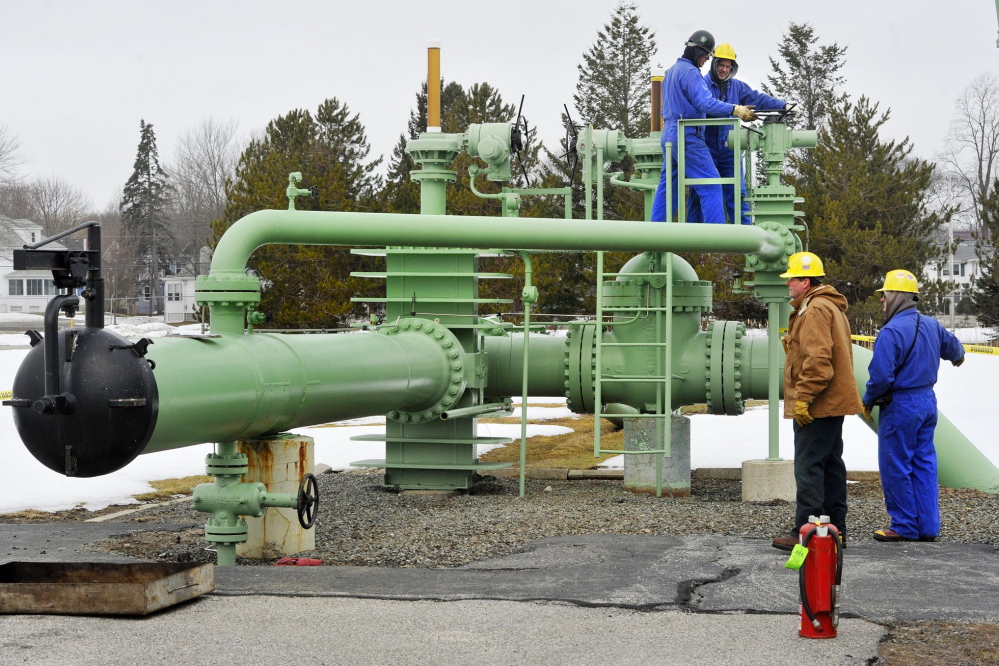PORTLAND — One of two pipelines stretching from Portland to Montreal has surpassed its life expectancy, an environmental group said Thursday, citing court documents. The Portland Pipe Line Corp. dismissed the assertion as “grossly misleading” and said its dual pipelines can operate safely for years to come.
Based on filings in a tax dispute in New Hampshire, the National Wildlife Federation said an 18-inch pipeline built in 1950 is four years beyond its anticipated retirement age. A 24-inch pipeline that runs alongside the smaller pipe was built in 1965, so it has more than a decade of use left, the environmental group said.
Owners of the pipeline company had agreed with the federal officials’ 60-year projected lifespan for purposes of a case in the 1990s in which it had disputed its tax assessment in Gorham, N.H.
A pipeline spokesman accused the environmental group of deliberately using technical property appraisal terms out of context, “all in a ploy to scare the public.”
The technical evaluation cited in the court documents was based on the pipeline’s projected economic and functional viability according to market conditions at the time, and that theoretical number had nothing to do with the length of time the pipelines can be operated safely, said spokesman Jim Merrill.
Modern pipelines, unlike older cast-iron pipelines, can be operated indefinitely if properly maintained and inspected, according to the Pipeline and Hazardous Materials Safety Administration.
“The U.S. DOT pipeline regulations do not set a lifespan limit on the use of any pipeline. As long as a pipeline is properly maintained and meets all of the safety regulations requirements, it can continue in use,” said Gordon “Joe” Delcambre Jr., spokesman for the agency, which is part of the U.S. Department of Transportation.
Skip Sansoucy, a utility appraiser who assessed the pipeline’s value for the town, said he’s confident that the pipeline can continue operating beyond 60 years, noting that the company has a great safety record. On the tax side, though, he’s served as an expert witness against the company during hard-fought battles over property taxes.
The pipeline company is trying to have it both ways, he said, when using the 60-year service life for tax purposes even though the pipeline can be safely operated longer.
Environmentalists fear the smaller pipeline, which is idle, could be used to bring oil derived from tar sands in western Canada across Vermont, New Hampshire and Maine en route to a waterfront terminal in South Portland. They say tar sands oil is more volatile than the crude currently transported over the larger pipeline, could accelerate corrosion and causes greater damage when it spills.
The pipeline company said there’s currently no plan to reverse flow to allow Canadian oil to flow southward.
But environmental groups remain concerned, especially after Canadian regulators approved a plan last week to reverse the flow of another pipeline that would allow oil from western Canada to be transported to Montreal.
The additional crude arriving in Montreal will likely negate the need for oil piped north from Portland, so Portland Pipe Line officials might feel economic pressure to reverse the flow of their pipeline to allow the Canadian crude to flow to Portland to be offloaded onto tankers, said Jim Murphy, senior counsel for National Wildlife Federation.
“It’s something that Mainers need to be concerned about,” he said.
The Portland Pipe Line previously explored the idea of building a pumping station in Quebec to facilitate the reversal of the pipeline, allowing Canadian crude to flow to Maine. It abandoned the idea a year ago, citing economic conditions, but left the door open to revisit the issue.
Last year, South Portland voters narrowly rejected a waterfront development referendum aimed at stopping the shipment of Canadian oil into the state.
The Portland Pipe Line said it has safely shipped more than 4 billion barrels of oil north to refineries in Canada since the pipeline company was created in 1941. The pipeline actually consists of three pipes but the oldest of them, built in 1941, was taken out of service decades ago.
Send questions/comments to the editors.



Success. Please wait for the page to reload. If the page does not reload within 5 seconds, please refresh the page.
Enter your email and password to access comments.
Hi, to comment on stories you must . This profile is in addition to your subscription and website login.
Already have a commenting profile? .
Invalid username/password.
Please check your email to confirm and complete your registration.
Only subscribers are eligible to post comments. Please subscribe or login first for digital access. Here’s why.
Use the form below to reset your password. When you've submitted your account email, we will send an email with a reset code.